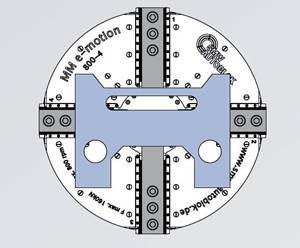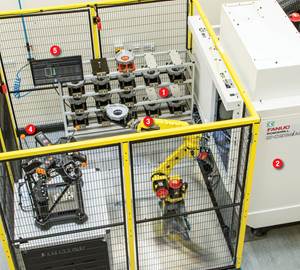Use Predictive Maintenance to See the Future
Predictive maintenance requires a relationship of trust between the machine manufacturer and the user in order to gain insights into the data.
Researchers at the Fraunhofer Institute for Production Systems and Design Technology (IPK) in Berlin, Germany, say they can foresee a machine tool’s performance more clearly and accurately with the aid of predictive maintenance. Predictive maintenance is a concept by which users can identify the optimum timing for maintenance procedures to avoid lost production and to optimize the processes involved. In a recent interview, Eckhard Hohwieler and Claudio Geisert, both from IPK, shared ideas about this concept and its promises, which are summarized here.
Predictive maintenance is not the same as condition monitoring. Condition monitoring detects and logs the current wear-and-tear status of a machine, whereas predictive maintenance tracks trends that forecast circumstances requiring service and plans the appropriate maintenance activities. The main benefit of this approach is that the maintenance staff carries out only the care and service work that is actually required. Effective predictive maintenance increases machine availability and reduces the number of maintenance routines needed. This work is carried out on pre-specified dates.
However, linking process monitoring and condition diagnostics is important. For example, one of IPK’s research projects for a machinery manufacturer involved creating a tool monitoring feature with no additional sensors or other electronics. A software package integrated into the control system monitors tool wear and fracturing. The algorithms check and corollate the machine’s condition and behavior automatically. This enables weak points to be determined with astonishing accuracy using the characteristic values of the drive shafts. Even textile flaws in belt drives have reportedly been discovered in this way.
Understandably, machine tool users are often reluctant to share data generated by this approach. They are concerned that sensitive information might be revealed to outsiders. However, sharing this data with the machine builder provides an opportunity to gain additional insights into the behavior of its machines in the field. A relationship of mutual trust between the manufacturer and the user, along with contractual safeguards for data usage, can overcome this impasse.
An example of such cooperation between a builder and users exists in the automotive industry, which demands guarantees on availability from the machinery manufacturers plus details of the anticipated lifecycle costs. This, however, necessitates comprehensive monitoring of the machine involved. One solution developed by IPK in conjunction with grinding machine manufacturer Schaudt-Mikrosa involves electronic monitoring of machine drive components using the machine’s own control system. The system captures and evaluates all messages and signals from the machine, and then uses this data to determine the dynamic behavior of the drive shafts and spindles over a lengthy period.
In this case, the system is already being used as an important tool for quality assurance in the machinery acceptance-testing phase, and in the warranty phase to clarify causes of damage, such as collisions between drive elements, tools and components. Likewise, the user’s service personnel have a tool for looking into the past based on comprehensive data acquisition and storage. They see when and under what circumstances problems occurred for the first time, and can thus more easily identify how they can be remedied.
To avoid data overload, the system is not designed to acquire all raw data, but rather to capture “smart data, not big data.” Developers had to determine and store only the values for typical characteristics. A concise data record is then uploaded to the cloud. It is critical to understand what physical variables should be acquired using specific sensors and appropriate levels of accuracy. Without this expertise, a monitoring concept cannot be translated into a viable predictive maintenance function.
The long-term benefits of predictive maintenance for the manufacturer are clear. It creates a “fleet effect.” Over the course of a production line’s lifecycle at the customer’s facility, this body of usable, manageable information enables the manufacturer’s service capabilities to be greatly improved.
Other possibilities are also conceivable, such as a machine utilizing the information internally to optimize its processes or to initiate a call for maintenance service automatically.
Related Content
Machine Monitoring Boosts Aerospace Manufacturer's Utilization
Once it had a bird’s eye view of various data points across its shops, this aerospace manufacturer raised its utilization by 27% in nine months.
Read MoreShop Moves to Aerospace Machining With Help From ERP
Coastal Machine is an oil and gas shop that pivoted to aerospace manufacturing with the help of an ERP system that made the certification process simple.
Read MoreWireless Couplers Work Wonders for Workholding
Possibilities range from individual control of chuck jaws and tombstone fixtures to more reliable robots.
Read More5 Stages of a Closed-Loop CNC Machining Cell
Controlling variability in a closed-loop manufacturing process requires inspection data collected before, during and immediately after machining — and a means to act on that data in real time. Here’s one system that accomplishes this.
Read MoreRead Next
3 Mistakes That Cause CNC Programs to Fail
Despite enhancements to manufacturing technology, there are still issues today that can cause programs to fail. These failures can cause lost time, scrapped parts, damaged machines and even injured operators.
Read MoreThe Cut Scene: The Finer Details of Large-Format Machining
Small details and features can have an outsized impact on large parts, such as Barbco’s collapsible utility drill head.
Read More












.png;maxWidth=300;quality=90)









